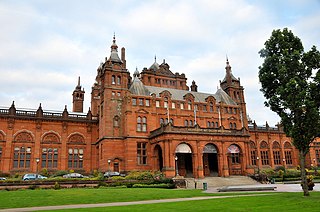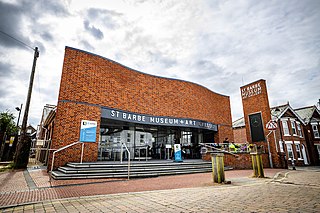Related Research Articles

Arts Council England is an arm's length non-departmental public body of the Department for Culture, Media and Sport. It is also a registered charity. It was formed in 1994 when the Arts Council of Great Britain was divided into three separate bodies for England, Scotland and Wales. The arts funding system in England underwent considerable reorganisation in 2002 when all of the regional arts boards were subsumed into Arts Council England and became regional offices of the national organisation.

Kelvingrove Art Gallery and Museum is a museum and art gallery in Glasgow, Scotland, managed by Glasgow Museums. The building is located in Kelvingrove Park in the West End of the city, adjacent to Argyle Street. Kelvingrove Art Gallery and Museum is one of Scotland's most popular museums and free visitor attractions.

The Museum of English Rural Life, also known as The MERL, is a museum, library and archive dedicated to recording the changing face of farming and the countryside in England. The museum is run by the University of Reading, and is situated in Redlands Road to the rear of the institution's London Road Campus near to the centre of Reading in southern England. The location was formerly known as East Thorpe House and then St Andrew's Hall. It is an accredited museum and accredited archive as recognised by Arts Council England and the National Archives.
The Museums Association (MA) is a professional membership organisation based in London for museum, gallery and heritage professionals and organisations of the United Kingdom. It also offers international membership.
The Institute of Conservation(Icon) is the professional charitable body, representing and supporting the practice and profession of conservation. It has around 2500 members worldwide, including professional conservators, scientists and teachers involved with the care of heritage objects and buildings.

The Lapworth Museum of Geology is a geological museum run by the University of Birmingham and located on the university's campus in Edgbaston, south Birmingham, England. The museum is named after the geologist Charles Lapworth, its origins dating back to 1880. It reopened in 2016 following a £2.7 million redevelopment project that created new galleries and displays, as well as modern visitor and educational facilities.

The Fry Art Gallery is an art gallery in Saffron Walden, Essex. Recognised as an Accredited Museum by Arts Council England, it displays work by artists of national significance who lived or worked in North West Essex during the twentieth century and after. The gallery is known for its comprehensive collection of work by the Great Bardfield Artists, including Edward Bawden and Eric Ravilious.

The Museum of Croydon is a museum located within the Croydon Clocktower arts facility in Central Croydon, England. It showcases historical and cultural artefacts relating to the London Borough of Croydon and its people. The museum is owned and run by Croydon Council.
The Wiltshire and Swindon History Centre in Chippenham, Wiltshire, England, serves as a focal point for heritage services relating to Wiltshire and Swindon. The centre opened in 2007 and is funded by Wiltshire Council and Swindon Borough Council. It has purpose-built archive storage and research facilities and incorporates the local studies library, museums service, archaeology service, Wiltshire buildings record and the conservation service.
The Collections Trust is an independent UK-based charity that works with museums, libraries, galleries and archives worldwide to improve the management and use of collections. It was established in February 1977 as the Museum Documentation Association (MDA) and re-launched as the Collections Trust in 2008. Its head office is in Shoreditch, London.
Museums Galleries Scotland (MGS), formerly the Scottish Museums Council, is the National Development Body for the museum sector in Scotland. It offers support to 400 museums and galleries, ranging from small local museums to larger regional and national museums. It is the Scottish partner in the UK Museum Accreditation Scheme.

Kingston Museum is an accredited museum in Kingston upon Thames, southwest London, England. The Scottish-American philanthropist Andrew Carnegie funded the building of the museum, which adjoins Kingston Library.

Acceptance in lieu (AiL) is a provision in British tax law under which inheritance tax debts can be written off in exchange for the acquisition of objects of national importance. It was originally established by Chancellor of the Exchequer David Lloyd George as a means for the wealthy to pay the increased estate taxes imposed by his People's Budget of 1909 but had its roots in similar schemes dating to the late 19th century. It has developed from the early years, when it was used mainly as a means for the aristocracy to dispose of country estates to the National Trust, to the modern day, when it is more associated with the transfer of works of art, antiquities and archive material to museums. The scheme is administered by Arts Council England, a non-departmental public body of the Department for Culture, Media and Sport. The scheme has brought many houses, works of art and other collections into publicly accessible institutions when they would otherwise have gone to auction. In April 2013 the Cultural Gifts Scheme was started which allows taxpayers to make a donation of art in return for a credit on income tax, capital gains tax or corporation tax. The Cultural Gifts Scheme is also administered by Arts Council England and is reported jointly with the Acceptance in Lieu scheme.

The Contemporary Art Society (CAS) is an independent charity that champions the collecting of outstanding contemporary art and craft for UK museum collections. Since its founding in 1910 the organisation has donated over 10,000 works to museums across the UK. From the 1930s the Society also donated works to Commonwealth museums, but since 1989 the focus has remained exclusively on UK institutions.

The Northampton Sekhemka statue is an ancient Egyptian artefact, given by the Marquess of Northampton to Northampton Museum, in or around 1870. The statue dates from the 5th dynasty and depicts Sekhemka the scribe with his wife, Sitmerit. It was the subject of a controversial sale in July 2014, that raised questions of the museum's ownership and the ethics of selling artefacts. The statue was sold to an unidentified buyer for £15.76m, which broke the world record for Ancient Egyptian art at auction. On 1 August 2014, Northampton Museums had their accreditation removed by Arts Council England, which ruled that the sale did not meet the accredited standards for museums in managing their collections.

St Barbe Museum + Art Gallery is a local museum and art gallery in Lymington, Hampshire, England.

Paintings in Hospitals is an arts in health charity in the United Kingdom. Founded in 1959, the charity's services include the provision of artwork loans, art projects and art workshops to health and social care organisations. The charity's activities are based on clinical evidence demonstrating health and wellbeing benefits of the arts to patients and care staff.

The City Art Centre is part of the Museums & Galleries Edinburgh, which sits under the Culture directorate of the City of Edinburgh Council. The City Art Centre has a collection which include historic and modern Scottish painting and photography, as well as contemporary art and craft. It is an exhibition based venue with no permanent displays.
Evelyn Ann Silber is an English art historian and an acknowledged specialist on 20th century British sculpture. She is an honorary Professorial Research Fellow at the University of Glasgow and is researching the marketing of modernist art in early 20th century London and the role played by dealers. Having moved to Glasgow in 2001 to assume the role of Director of the Hunterian Museum and Art Gallery, Silber continues to be based there and is an advocate for Glasgow’s cultural heritage, the conservation of the city, and its tourist industry. She is currently the Chair of the Scottish Archaeological Finds Allocation Panel.
References
- ↑ Stevens, Alex (2018-11-02). "Accreditation scheme relaunched for 30th anniversary". Museums Association. Retrieved 2024-07-24.
- 1 2 Woodhead, Charlotte (2023-11-23). Caring for Cultural Heritage: An Integrated Approach to Legal and Ethical Initiatives in the United Kingdom. Cambridge University Press. ISBN 978-1-108-57950-6.
- 1 2 3 Macdonald, Sharon (2011-08-24). A Companion to Museum Studies. John Wiley & Sons. ISBN 978-1-4443-5794-3.
- 1 2 3 4 "Accreditation Scheme". Museums Galleries Scotland. Retrieved 2024-07-24.
- 1 2 "UK Museum Accreditation Scheme". Council of Australasian Museum Directors. 2017-01-25. Retrieved 2024-07-24.
- ↑ Murphy, Adrian (2018-11-02). "What are the new changes to the Museum Accreditation Scheme?". Museums + Heritage. Retrieved 2024-07-24.
- 1 2 "UK Museum Accreditation Scheme". Arts Council England. Retrieved 2024-07-24.
- ↑ "Accreditation Scheme for Museums and Galleries in the United Kingdom: COVID-19 Update". Association of Independent Museums.
- ↑ "Accreditation". Collections Trust. Retrieved 2024-07-24.
- ↑ "Managing collections". Collections Trust. Retrieved 2024-07-24.
- ↑ Cunliffe, Emma; Fox, Paul (2022). Safeguarding Cultural Property and the 1954 Hague Convention: All Possible Steps. Boydell & Brewer. ISBN 978-1-78327-666-0.
- ↑ "Users and their experiences". Collections Trust. Retrieved 2024-07-24.
- ↑ "Advice – About the UK Museum Accreditation Scheme". Museum Development North. Retrieved 2024-07-24.
- 1 2 Atkinson, Rebecca (2013-01-30). "MGS to charge non-subscribers for Accreditation". Museums Association. Retrieved 2024-07-24.
- ↑ Winney, Becky (2014-12-15). "Arts Council announces new chair of the Museums Accreditation Committee". Museums + Heritage. Retrieved 2024-07-24.
- ↑ "FAQs". Museums Association. Retrieved 2024-07-24.
- ↑ "The museums map: Mapping access to England's museums". nesta. Retrieved 2024-07-24.
- ↑ "Women making an exhibition of themselves". BBC News. 2017-12-24. Retrieved 2024-07-24.
- ↑ "Museum & Gallery Exhibitions Tax Relief FAQs" (PDF). Arts Council England. Retrieved 28 August 2024.
- ↑ Hardaker, Alistair (2023-06-02). "Arts Council England to invest £20m in second round of investment programme". Museums + Heritage. Retrieved 2024-07-24.
- ↑ Styles, David (2021-06-22). "Art Fund welcomes applications from museums and galleries for Weston Loan Programme". Museums + Heritage. Retrieved 2024-07-24.
- ↑ "Museums to benefit from £24 million investment to fund major infrastructure projects". GOV.UK. Retrieved 2024-07-24.
- ↑ "ACE cuts funding for museum development work". ArtsProfessional. Retrieved 2024-07-24.
- ↑ "Grants to help small museums celebrate local science stories". Museums Association. 2022-01-07. Retrieved 2024-07-24.
- ↑ "'Rebel' museums face funding blacklist". BBC News. 2015-03-27. Retrieved 2024-07-24.
- ↑ Murphy, Adrian (2015-09-03). "Bury Art Museum: Touring its way out of trouble". Museums + Heritage. Retrieved 2024-07-24.
- ↑ "Kirkcudbright Viking treasure bid could need £1m". BBC News. 2015-07-07. Retrieved 2024-07-24.
- ↑ Krmpotich, Cara; Stevenson, Alice (2024-07-22). Collections Management as Critical Museum Practice. UCL Press. ISBN 978-1-80008-704-0.
- ↑ "Accreditation for Northampton museum with 3,500-year-old loincloths". BBC News. 2022-07-04. Retrieved 2024-07-24.
- ↑ Candlin, Fiona (2017-05-18). Micromuseology: An Analysis of Small Independent Museums. Bloomsbury Academic. ISBN 978-1-350-04010-6.
- ↑ Kendall Adams, Geraldine (2025-01-30). "ACE announces review of Museum Accreditation scheme". Museums Association. Retrieved 2025-02-03.